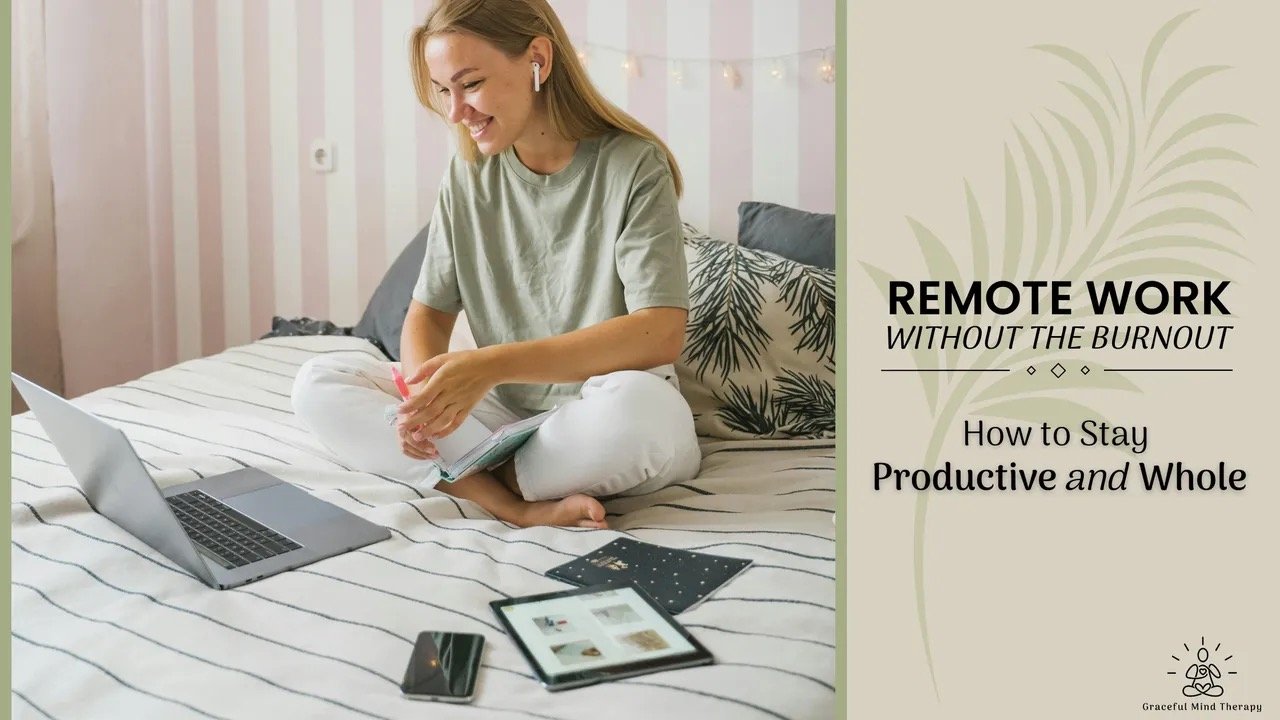Remote Work Without the Burnout: How to Stay Productive and Whole
Remote work is here to stay. For some, it’s a “I’m never going back” no-brainer: no commute, more flexibility, and the comfort of working from your own space (what's not to like?). For others, it’s been more of a mixed bag. Maybe it’s felt isolating, or harder to stay focused without the usual structure. And for a lot of us, it depends on the day. Sometimes it’s a gift. Sometimes it’s a grind.
By 2025, we’ve had enough time to know that remote work isn’t just about having Wi-Fi and a decent chair. It’s about finding a rhythm that supports both your career and your well-being (and that’s not always easy!).
In this post, I’ll walk through ways to make the most of the freedom remote work offers, while also tackling some of the common challenges that can come with it. Because what I’ve learned after 10 years of working remotely is that, when it’s working well, remote work can feel sustainable, productive, and yes, even fulfilling. And when it’s not…well, it can wear you down fast.
Start with What Energizes You
It’s tempting to roll out of bed and dive straight into emails or scrolling on social media. But starting your day that way usually puts you in reactive mode, responding to everything and everyone but yourself.
Instead, ask yourself: What’s one thing I can do this morning that would help me feel accomplished? It doesn’t have to be huge, just meaningful. Maybe it’s a small step on a project you’ve been avoiding, or a walk to get your mind and body moving. Starting with something that gives you a sense of progress can snowball into more motivation throughout the day.
In fact, motivation often works like that; it’s not a switch you flip, it’s something you build, moment by moment. If you’re feeling stuck, don’t wait for inspiration. Just start small. Break the task down. Celebrate the win of sending that one email or editing that one paragraph. That early momentum matters.
Just like paying off the smallest debt first helps you build confidence in your financial habits and stay engaged, knocking out one thing that energizes you can make the rest of your day feel more doable. It’s less about doing what’s “urgent” and more about doing what makes you feel grounded and capable right out of the gate. Beginning your day with intention instead of urgency can shift your whole mindset—from rushed and reactive to grounded and confident.
Time Management that Honors Your Energy
One of the biggest traps in remote work is feeling like you have to constantly prove your productivity. That often means pushing through fatigue, skipping meals, or saying yes to every ping and meeting request. But staying “on” all day doesn’t automatically equal getting more done. Moving your mouse so you can stay on green is not the goal here (IYKYK). What matters more than how long you work is how well you align your time with your natural energy and focus.
A lot of conventional advice encourages taking structured breaks every 25 or 50 minutes, following methods like the Pomodoro Technique. For some people, that rhythm works beautifully. If you're someone who thrives on routine, using timers and pre-determined intervals might be for you. But others may find that following a strict schedule interrupts momentum more than it helps. For certain tasks or temperaments, it’s the deep, uninterrupted stretches—the ones where you lose track of time because you're immersed in something meaningful—that bring the most energy and satisfaction. Tuning in to what actually fuels your focus (instead of following someone else’s formula) helps you drop into that sweet spot where you're both productive and at peace.
If you’re curious about how to cultivate more of that immersive, satisfying focus, two good reads are Deep Work by Cal Newport and Flow by Mihaly Csikszentmihalyi. Both highlight the benefits of going deep, and offer thoughtful perspectives on how we learn, create, and perform at our best—not by doing more, but by doing things differently.
When Focus Fades, Try Shifting Gears—Not Shutting Down
Of course, even the best focus has its limits. Our minds naturally need breaks, but that doesn’t always mean stopping everything and vegetating in bed. Sometimes, it just means doing something different. Research suggests that one way to support sustained learning, creativity, and performance is by engaging different regions of the brain through varied types of activity. This concept is sometimes referred to as interleaving: alternating between tasks that draw on different cognitive functions. Instead of traditional multitasking, which tends to scatter our attention, this is more like sequential or linear multitasking: giving full focus to one task at a time, then moving to something entirely different. Think of an accountant stepping away from spreadsheets to spend time painting, or a therapist organizing her workspace after writing notes. These transitions stimulate different parts of the brain, refresh your mental state, and often lead to unexpected insights. Letting your mind wander during these transitions can also be incredibly fruitful. How often do your best ideas come to you in the shower, on a walk, or while you're doing something totally unrelated to work? That’s not a coincidence. These mental shifts help “unstick” thinking, spark new connections, and relieve cognitive overload. What feels like a break is often your brain continuing to process and problem-solve beneath the surface. If you're curious about the research behind this, Hidden Potential by Adam Grant explores how mixing different kinds of mental activity can enhance learning, boost creativity, and make work more sustainable in the long run.
Make Space for the Whole You
Remote work doesn’t just happen on a screen; it happens in your body, in your environment, and in your mind. That’s why it’s so important to create a setup that supports all of you, not just your productivity.
Start with your physical space. Your environment shapes your mood more than you might realize. A cluttered or uninspiring workspace can drain you before you even start the day. You don’t need an Instagram-worthy office—just a few small touches that make your space feel good to be in. A plant, soft music, adequate lighting, scented candle, a chair that doesn’t hurt your back. Feeling grounded physically helps you stay focused mentally.
But space isn’t just physical. Working remotely can blur the boundaries between work and life, especially when your office is your kitchen table. That’s why even small rituals—like changing into “working clothes,” setting clear start and end times for your workday, or designating a specific area for work—can make a big difference. Creating structure around where and when you work helps your brain shift gears and protects your time and energy.
And finally, don’t forget: you’re not just a brain with a to-do list. You’re a whole human. You have a body that needs movement, eyes that need a break from the screen, and emotions that deserve attention. Eat real meals. Get some fresh air. Text a friend. Practice small acts of self-care. Say no to that meeting that could’ve been an email. Remote work gives you flexibility, but it’s up to you to use that freedom in a way that supports your well-being, not just your output. This is especially important for women and professionals who often carry invisible loads that make balance more difficult to maintain.
Finding Balance for Women Seeking Support
Mastering remote work isn’t about perfect routines or squeezing out maximum output. It’s about creating a rhythm that honors your energy, your needs, and your well-being. When your work life supports your mental health and personal growth (not just your productivity), it’s easier to show up with clarity, motivation, and a sense of wholeness.
Your career matters. But so do you.
If you’re looking for more support around wellness, self-care, and mental health, especially in the context of modern work and life, I’m here to help. You can learn more about my approach and who I support on my
About Maria page, or visit the Graceful Mind Therapy home page to explore all available services.
Here’s to work that works for you—not just work you push through.
by Maria Perdomo-Torres, LCSW-S, MHA, CFSW




